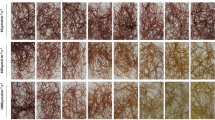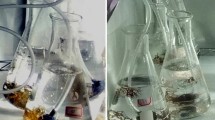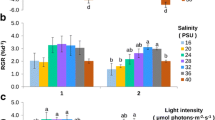Abstract
Laurencia brongniartii is usually found at depths below 4 m, but can be found in shallow subtidal areas in crevices and on the walls of a coral reef in Amami Oshima Island, Kagoshima Prefecture, Japan, where irradiances were significantly lower than those at similar depths in open water. In preparation for the possible cultivation of this species for its antibiotic compounds, the effects of temperature and irradiance on photosynthesis and growth were measured. Photosynthesis and growth rates of L. brongniartii explants were highest at 26 and 28 °C, which closely corresponded to temperatures found during August to late December when it was most abundant. The estimated maximum photosynthesis rate (P max) was 4.41 μmol photon m−2 s−1 at 26 °C and 4.07 μmol photon m−2 s−1 at 28 °C. Saturating irradiance occurred at 95 μmol photon m−2 s−1 at 26 °C and 65 μmol photon m−2 s−1 at 28 °C. In contrast, growth experiments at 41.7 μmol photon m−2 s−1 caused bleaching of explants and the maximum growth rate observed during the study was 3.02 ± 0.75% day−1 at 28 °C and 25 μmol photon m−2 s−1. The difference in the saturating irradiance for photosynthesis and the irradiance that caused bleaching in growth experiments suggests that long-term exposure to high irradiance was detrimental and should be addressed before the initiation of large scale cultivation.
Similar content being viewed by others
References
Altamirano M, Murakami A, Kawai H (2003) Photosynthesis per-formance and pigment content of different developmental stages of Ecklonia cava (Laminariales, Phaeophyceae). Bot. Mar. 46: 9–16.
Anthony KRN, Hoegh-Guldberg O (2003) Variation in coral pho-tosynthesis, respiration and growth characteristics in contrasting light microhabitats: An analogue to plants in forest gaps and understoreys? Funct. Ecol. 17: 246–259.
Dawes CJ, Kovach CW(1992) Ecology of the algae of a Florida Key, II: Effects of irradiance, salinity and desiccation on intertidal and subtidal populations of seven macroalgae. Bull. Mar. Sci 50: 165–170.
Dawes CJ, Orduña-Rojas J, Robledo D (1999) Response of the trop-ical red seaweed Gracilaria cornea to temperature, salinity and irradiance. J. Appl. Phycol. 10: 419–425.
Erickson KL (1983) Constituents of Laurencia. In Sheuer PJ (ed), Marine Natural Products, Vol. 5, Academic Press, New York, pp. 131–257.
Fenical W (1975) Halogenation in the Rhodophyta. A review. J. Phycol. 11: 245–259.
Häder DP, Gröniger A, Hallier C, Lebert M, Figueroa FL, Jimenéz C (1999) Photoinhibition by visible and ultraviolet radiation in the red macroalga Porphyra umbilicalis grown in the laboratory. Plant Ecol. 145: 351–358.
Horikawa M, Noro T, Kamei Y (1999) In vitro anti-methicillin-resistant Staphylococcus aureus activity found in extracts of ma-rine algae indigenous to the coastline of Japan. J. Antibiot. 52: 186–189 (in Japanese).
Irie T, Fukuzawa A, Izawa M, Kurosawa E (1969) Laurenisol, a new sesquiterpenoid containing bromine from Laurencia nipponica Yamada. Tetrahedron Lett. 10: 1343–1346.
Irie T, Suzuki M, Kurosawa E, Masamune T (1966) Laurinterol and debromolaurinterol, constituents from Laurencia interme-dia. Tetrahedron Lett. 7: 1837–1840.
Irie T, Suzuki M, Kurosawa E, Masamune T (1970) Laurinterol, debromolaurinterol, and isolaurinterol, constituents of Laurencia intermedia Yamada. Tetrahedron 26: 3271–3277.
Jimenez C, Figueroa FL, Salles S, Aguilera J, Mercado J, Viñegla B, Flores-Moya A, Lebert M, Häder DP (1998) Effects of solar radiation on photosynthesis and photoinhibition in red macro-phytes from an intertidal system of Southern Spain. Bot. Mar. 41: 329–338.
Kuwano K, Matsuka S, Kono S, Nonomiya M (1998) Growth and the content of laurinterol and debromolaurinterol in Laurencia okamurae (Ceramiales, Rhodophyta). J. Appl. Phycol. 10: 9–14.
Lapointe BE, Dawes CJ, Tenore KR (1984) Interactions between light and temperature on the physiological ecology of Gracilaria tikvahiae (Gigartinales: Rhodophyta), II: Nitrate uptake and levels of pigments and chemical constituents. Mar. Biol. 80: 171–178.
May V, Larkum AWD (1981) A subtidal transect in Jarvis Bay, New South Wales. Aus. J. Ecol. 6: 439–457.
McDermid KJ (1989) Laurencia crustiformans sp. nov. (Cerami-ales, Rhodophyta) from the Hawaiian Islands. Phycologia 28: 352–359.
McLachlan J (1973) Growth media—marine. In Stein JR (ed), Culture Methods and Growth Measurements, Cambridge University Press, Cambridge, UK, pp. 25–51.
Nishihara GN, Mori Y, Terada R, Noro T (2004) Habitat char-acteristics and seasonal changes of Laurencia brongniartii (Ceramiales, Rhodophyta) in Kagoshima, Southern Japan. Phycol. Res. 52: 30–37.
Rasband WS (2003) Image J. National Institute of Health, Bethesda, Maryland, USA. Available at: http://rsb.info.nih.gov/ij/.Accessed 1 January 2002.
Saito Y, Womersley HBS (1974) The Southern Australian species of Laurencia (Ceramiales, Rhodophyta). Aust. J. Bot. 22: 815–874.
Talling JF (1957) Photosynthetic characteristics of some fresh-water plankton diatoms in relation to underwater radiation. New Phytol. 56: 29–50.
Vooren CM (1981) Photosynthesis rates of benthic algae from the deep coral reef of Cura¸ cao. Aquat. Bot. 10: 143–154.
Yokohama Y (1968) An improved type of 'Product-meter', a differential gas-volumeter, and its application to measuring photosynthesis of seaweeds. Jpn. J. Phycol. 34: 34–42 (in Japanese).
Author information
Authors and Affiliations
Rights and permissions
About this article
Cite this article
Nishihara, G.N., Terada, R. & Noro, T. Photosynthesis and growth rates of Laurencia brongniartii J. Agardh (Rhodophyta, Ceramiales) in preparation for cultivation. Journal of Applied Phycology 16, 303–308 (2004). https://doi.org/10.1023/B:JAPH.0000047790.59265.fb
Issue Date:
DOI: https://doi.org/10.1023/B:JAPH.0000047790.59265.fb




